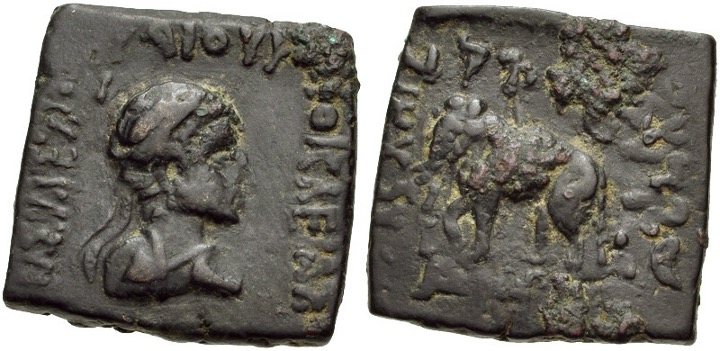3794 - Gandhara/Punjab (uncertain mint) (Heliocles II) (AE Zeus/elephant) over Strato I? (Heracles/Nike) (CNG, EA 215, July 2009, 345)
From SILVER
| Line 1: | Line 1: | ||
{{Overstrike | {{Overstrike | ||
| − | |Sale=Classical Numismatic Group EA 215 | + | |Image overstriking coin=SO_2093_-_Gandhara-Punjab_(uncertain_mint)_(Heliocles_II).jpg |
| + | |Sale=Classical Numismatic Group, EA 215, 29 July 2009, 345 | ||
|Obverse legend=ΒΑΣΙΛΕΩΣ ΔΙΚΑΙΟΥ ΗΛΙΟΚΛΕΟΥΣ | |Obverse legend=ΒΑΣΙΛΕΩΣ ΔΙΚΑΙΟΥ ΗΛΙΟΚΛΕΟΥΣ | ||
| − | |Obverse description= | + | |Obverse legend language=Greek |
| − | |Reverse legend=Maharajasa dhramikasa Heliyakreyasa ( | + | |Obverse description=Diademed, draped bust of Zeus right. |
| + | |Reverse legend=Maharajasa dhramikasa Heliyakreyasa (of Great king Heliokles the Just) | ||
| + | |Reverse legend language=Kharoshthi | ||
|Reverse description=Elephant walking left. In exergue, monogram. | |Reverse description=Elephant walking left. In exergue, monogram. | ||
| − | |Mint= | + | |Mint=Taxila |
| − | |Ancient region= | + | |Ancient region=Gandhara |
| − | |Authority=Heliocles II of Bactria (Indo-Greek king, c. 95-80 BC) | + | |Authority=Heliocles II of Bactria (Indo-Greek king, c. 95-80 BC); Indo-Greek kingdom |
| − | |Date from= | + | |Date from=90 BCE |
| − | |Date to= | + | |Date to=75 BCE |
|Period=hellenistic | |Period=hellenistic | ||
| + | |Metal=Bronze | ||
|Weight=9.05 | |Weight=9.05 | ||
|Diameter=20 | |Diameter=20 | ||
| − | |Axis=12 | + | |Axis=12 |
| + | |Denomination=denomination B | ||
|Standard=Indian (Hoover) | |Standard=Indian (Hoover) | ||
| − | |Coin series reference= | + | |Coin series reference=Mitchiner 1975, p. 165, type 294 ; Bopearachchi 1991, p. 284 and pl. 42, série 7 ; HGC 12, n° 384. |
| − | |Overstruck authority=Strato I (Indo-Greek king, c. 125-110 BC) | + | |Coin series web reference=https://numismatics.org/bigr/id/bigr.heliocles_ii.11 |
| + | |Overstruck authority=Strato I (Indo-Greek king, c. 125-110 BC); Indo-Greek kingdom | ||
| + | |Overstruck date from=110 BCE | ||
| + | |Overstruck date to=100 BCE | ||
| + | |Overstruck period=Hellenistic | ||
}} | }} | ||
Revision as of 16:47, 8 July 2023
90 BCE - 75 BCEΒΑΣΙΛΕΩΣ ΔΙΚΑΙΟΥ ΗΛΙΟΚΛΕΟΥΣ | Maharajasa dhramikasa Heliyakreyasa (of Great king Heliokles the Just)
Location/history
| Sale(s)Sale(s) ᵖ: | Classical Numismatic Group, EA 215, 29 July 2009, 345 | |
Overstriking coin
Description
| ObverseInscription or printing placed on the obverse.: | ΒΑΣΙΛΕΩΣ ΔΙΚΑΙΟΥ ΗΛΙΟΚΛΕΟΥΣ (Greek) Diademed, draped bust of Zeus right. | ReverseInscription or printing placed on the reverse.: | Maharajasa dhramikasa Heliyakreyasa (of Great king Heliokles the Just) (Kharoshthi) Elephant walking left. In exergue, monogram. |
Mint and issuing power
| MintIdentifies the place of manufacture or issue of a numismatic object.: | Taxila | Ancient regionAncient region. | Gandhara | Modern countryModern country: Afghanistan | AuthorityIdentifies the issuing power. The authority can be "pretended" when the name or the portrait of X is on the coin but he/she was not the issuing power. It can also be "uncertain" when there is no mention of X on the coin but he/she was the issuing power according to the historical sources: | Heliocles II of Bactria (Indo-Greek king, c. 95-80 BC), Indo-Greek kingdom |
Chronology
| FromIdentifies the initial date in a range assigned in a numismatic context. 90 BCE toIdentifies the final date in a range assigned in a numismatic context.. 75 BCE | hellenistic periodTime period of the numismatic object. |
Physical description
| MetalThe physical material (usually metal) from which an object is made.: Bronze |
WeightWeight of the numismatic object (in grams). in grams: 9.059.05 g <br />9,050 mg <br /> | DenominationTerm indicating the value of a numismatic object. Examples: tetradrachm, chalkous, denarius.: denomination B | AxisDescribes the directional relationship between the obverse and reverse of a numismatic object.: 1212 mm <br />1.2 cm <br /> |
| DiameterDescribes diameter of an object (in mm).: 2020 mm <br />2 cm <br /> | StandardStandard.: Indian (Hoover) | ||
References
| Coin referenceReference of the Coin: | Coin series referenceReference to coin series study: | Mitchiner 19751Mitchiner 1975, p. 165, type 294, Bopearachchi 19912Bopearachchi 1991, p. 284 and pl. 42, série 7, HGC 123HGC 12, n° 384. | |
| Coin series web referenceCoin series web references: | |||
Overstruck type
Description
| ObverseInscription or printing placed on the obverse.: | ReverseInscription or printing placed on the reverse.: |
Mint and issuing power
| MintIdentifies the place of manufacture or issue of a numismatic object. ᵖ: | Ancient regionAncient region. ᵖ | Modern countryModern country: | AuthorityIdentifies the authority in whose name (explicitly or implicitly) a numismatic object was issued. ᵖ: | Strato I (Indo-Greek king, c. 125-110 BC), Indo-Greek kingdom |
Chronology
| FromIdentifies the initial date in a range assigned in a numismatic context. 110 BCE toIdentifies the final date in a range assigned in a numismatic context.. 100 BCE | Hellenistic 323-30 BC |
Physical description
References
| Coin type referenceReference to coin series study ᵖ: |
Additional data
| Frequency of overstrikesFrequency of overstrikes: | Level of confidenceLevel of confidence of the identification: | ||
| RemarksRemarks: | |||
References
- ^ Mitchiner, Michael (1975), Indo-Greek and Indo-Scythian coinage, London,
- ^ Bopearachchi, Osmund (1991), Monnaies gréco-bactriennes et indo-grecques : catalogue raissoné, Paris, 459 p., 69 pl.
- ^ Hoover, Oliver D. (2013), Handbook of coins of Baktria and ancient India : including Sogdiana, Margiana, Areia, and the Indo-Greek, Indo-Skythian, and native Indian states south of the Hindu Kush, fifth century BC to first century, Lancaster-London,
